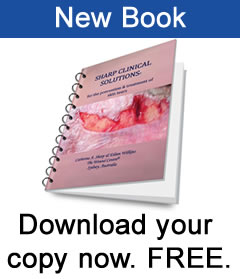‘Outside the box’ thinking about pressure injury prevention.
Do you sometimes feel confused about pressure injury prevention?
Are you faced with having to read hundreds of pages of Guidelines, using time-consuming risk screening tools for every patient, then not knowing which alternating pressure air mattress to order, or worse still being told you don’t need a mattress – just keep repositioning the patient – and we know that won’t work.
Well you’re not alone…so let me make it easy for you. I know I am very ‘outside the box’ when it comes to common and recommended practice for pressure injury prevention, but I would rather be a …………..**
Find out what by clicking on this link below or copy and paste it into your browser
http://iirhealthcare.wordpress.com/2013/08/26/out-of-the-box-thinking-in-pressure-injury-prevention/
Feel free to share it with your colleagues. Check out my books on pressure injury prevention – you’ll see these when you click on the link above and read the article – and you’ll be able to click straight to the books.
Let me know what you’re doing in your workplace and what you think.
Email me at info@thewoundcentre.com
Kate 🙂
Clinical judgement must override any score you get when using a numerical pressure ulcer risk assessment tool.
So how do you assess a patient using clinical judgement?
Ask the patient if they can:
1. lift their arms up / off the bed
2. lift their legs up / off the bed
3. roll from side to side
If the patient cannot perform these movements they are at risk of pressure injury / ulcer.
Simple…
You can use this very quick and very simple 15 second assessment when you don’t have time to fill in a complicated, time-consuming, assessment tool that contains parameters that are irrelevant to pressure injury development e.g. incontinence and poor nutrition.
Pressure Sores: The Nurse You’re Killing Me! Series
The Title of my latest book may make you see red!!
But I have written it in support of all healthcare workers, in particular nurses who are charged with the responsibility of preventing pressure sores without the tools or equipment to do so.
Click on the link.
http://clicks.aweber.com/y/ct/?l=87f1J&m=JaWH9V2Pt3VtJr&b=19uye6niP_btDhlER9NDTQ
Enjoy & send to everyone you know.
Then let me know what you think, post a comment on the blog and read what everyone around the world thinks!
Sharp Clinical Solutions for the Prevention of Pressure Injuries
Our first book ‘Sharp Clinical Solutions for the prevention and treatment of skin tears,’ free on this website, has been downloaded thousands of times by people around the world and we’ve had wonderful feedback so we thought we’d write more.
If you enjoyed it and found it helpful you might like to check out our latest book ‘Sharp Clinical Solutions for the Prevention of Pressure Injuries’ available on Amazon.
Click on this link.
Pressure injuries, also known as pressure ulcers, bedsores or decubitus ulcers, are appalling wounds that occur when soft tissue is ‘compressed’ between the skeleton and a surface e.g. a mattress or chair cushion, for a period of time. That time is different for every patient but tissue can begin to die in just a few minutes of unrelieved pressure.
The unrelieved pressure can destroy muscle, fat, bone and skin. Pressure injuries are extremely painful wounds that become infected and may result in limb amputation and / or death.
Pressure injuries are easy to prevent with mattresses and chair cushions that relieve pressure on all parts of the body every few minutes throughout the 24 hours.
Patients often sue healthcare facilities for the development of a pressure injury so it’s a good idea to find out how to prevent them.
The frantic patient who cannot speak…
All of you working in healthcare facilities can probably picture the frantic patient; the patient who cannot speak, who perhaps has had a stroke and is banging on the bed table, red-faced and desperately trying to talk, to tell you something…
Is he in pain? It could be the pain of unrelieved pressure in his ischial tuberosities. We’d better make sure it’s not the development of pressure injuries / ulcers!
Has he forgotten his name? Forgotten where he lives? Frantic because he doesn’t know why he is in hospital… Nobody has explained. He wants his wife but cannot remember her name or phone number??
Here’s the true story of one stroke survivor and his lengthy challenge trying to understand what’s happened and his desperate need to talk.
See ‘Letters in a Lake’ at http://www.amazon.com/dp/B00AZJOE7G

